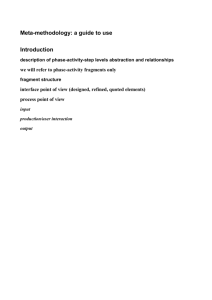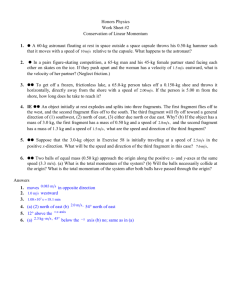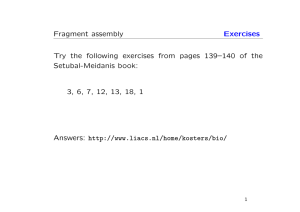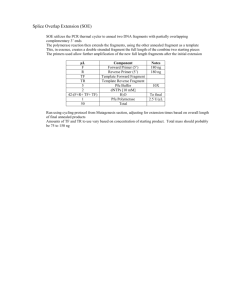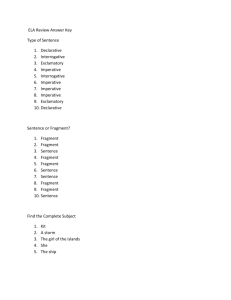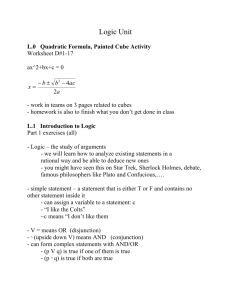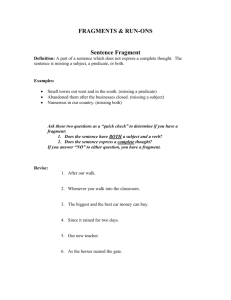What about Linear Logic in Computer Science? Daniel Mihályi, Valerie Novitzká
advertisement
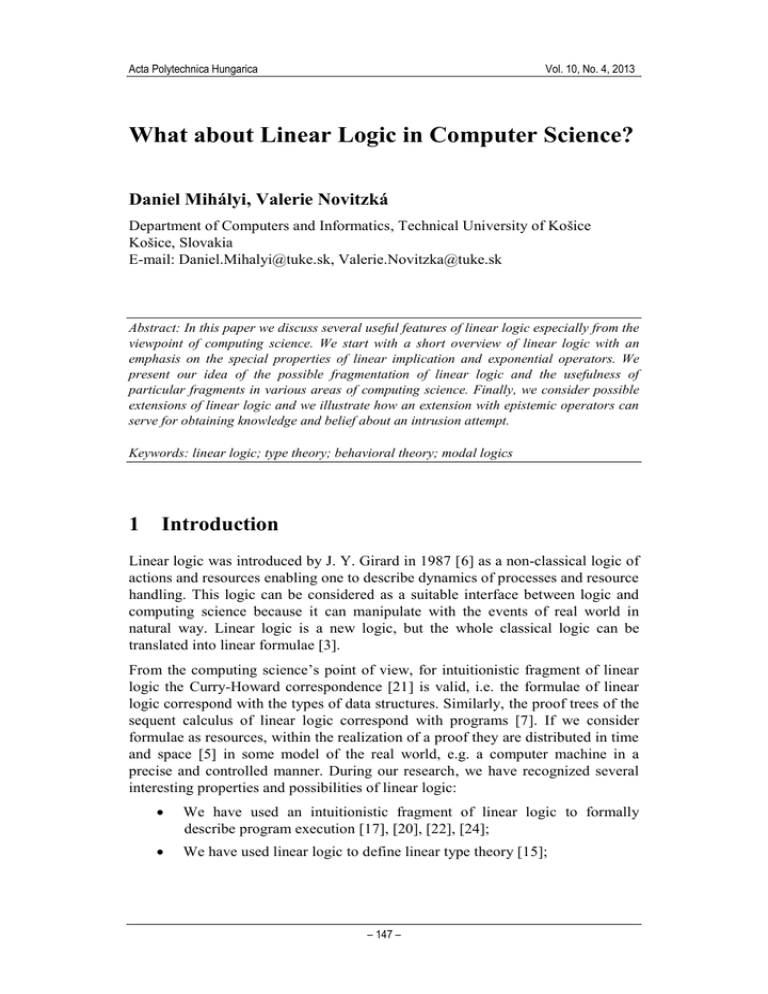
Acta Polytechnica Hungarica
Vol. 10, No. 4, 2013
What about Linear Logic in Computer Science?
Daniel Mihályi, Valerie Novitzká
Department of Computers and Informatics, Technical University of Košice
Košice, Slovakia
E-mail: Daniel.Mihalyi@tuke.sk, Valerie.Novitzka@tuke.sk
Abstract: In this paper we discuss several useful features of linear logic especially from the
viewpoint of computing science. We start with a short overview of linear logic with an
emphasis on the special properties of linear implication and exponential operators. We
present our idea of the possible fragmentation of linear logic and the usefulness of
particular fragments in various areas of computing science. Finally, we consider possible
extensions of linear logic and we illustrate how an extension with epistemic operators can
serve for obtaining knowledge and belief about an intrusion attempt.
Keywords: linear logic; type theory; behavioral theory; modal logics
1
Introduction
Linear logic was introduced by J. Y. Girard in 1987 [6] as a non-classical logic of
actions and resources enabling one to describe dynamics of processes and resource
handling. This logic can be considered as a suitable interface between logic and
computing science because it can manipulate with the events of real world in
natural way. Linear logic is a new logic, but the whole classical logic can be
translated into linear formulae [3].
From the computing science’s point of view, for intuitionistic fragment of linear
logic the Curry-Howard correspondence [21] is valid, i.e. the formulae of linear
logic correspond with the types of data structures. Similarly, the proof trees of the
sequent calculus of linear logic correspond with programs [7]. If we consider
formulae as resources, within the realization of a proof they are distributed in time
and space [5] in some model of the real world, e.g. a computer machine in a
precise and controlled manner. During our research, we have recognized several
interesting properties and possibilities of linear logic:
We have used an intuitionistic fragment of linear logic to formally
describe program execution [17], [20], [22], [24];
We have used linear logic to define linear type theory [15];
– 147 –
D. Mihályi et al.
What about Linear Logic in Computer Science?
In the sense of Curry-Howard correspondence, functional programming
can be regarded as logical reasoning in linear logic. Linear proofs enable
us to anticipate computability and correctness of computing [18], [19];
Formulae are equivalent with some paterns of Petri nets [8], [9], [15];
Extending linear logic with modal operators of necessity and possibility
we have used modal linear logic for reasoning about the observable
behavior of programs [13];
Extending linear logic with epistemic operators of knowledge and belief
we obtained epistemic linear logic useful for achieving experiences about
incomming network intrusions based on a natural manner of causalities
[13], [14].
The aim of this paper is to discuss several interesting features of linear logic and
the possible applications of linear logic in several areas of computing science. We
consider propositional linear logic. The second section contains a short
introduction to linear logic with special emphasis on its modal operators and on
the static and dynamic nature of linear implication. In the third section, we present
our view of linear logic fragmentation that can serve for different purposes in
various areas of computing science. In the fourth section, we show how classical
logic can be expressed by linear logic. The fifth section shows the correspondence
between linear logic and linear type theory. In the sixth section, we show how an
extension of linear logic with epistemic modalities of knowledge and belief can
provide useful information about the behaviour of programs.
2
Linear Logic Overview
In this section we introduce the basic notions of linear logic. Let Props={p1, p2…}
be a countable set of atomic propositions denoted by the letters p1,p2…. Any
proposition can be considered in two ways: as an action or as a resource. A linear
formula can be of the form defined by the following BNF rule:
:: pn | 0 | 1 || Τ |! | ? | | | | 1 2 | 1 & 2 | 1 2
(1)
| |
1 2 1
2
Linear logic has two conjunction operators and two disjunction operators. We
describe an informal meaning of linear connectives:
Linear implication 1 2 is causal; - it expresses that an action
described by 1 is a cause of the (re)action described by 2. If we
consider resources, a resource 1 is consumed after linear implication, i.e.
it becomes a linear negation 1;
– 148 –
Acta Polytechnica Hungarica
Vol. 10, No. 4, 2013
Multiplicative conjunction (“times”) 1 2 has the neutral element 1.
It expresses that both actions 1 and 2 will be performed simultaneously
or that we have both resources 1 and 2 at once.
Additive conjunction (“with”) 1 & 2 has the neutral element T. It
expresses that only one of the actions described by 1 and 2 will be
performed. But we can deduce or anticipate from an environment which
of them will be performed. This formula can be considered as an analogy
with the statements if-then-else and case in programming languages.
Somethimes it is called external nondeterminism (dependent choice);
Additive disjunction (“plus”) 1 2 has the neutral element 0. It
expresses that only one of the actions described by 1 and 2 will be
performed (or only one of these resources is available), but we cannot
anticipate which one. It can be considered internal nondeterminism (free
choice);
Multiplicative disjunction (“par”) 1 2 has the neutral element and
its meaning can be expressed as follows: if an action 1 is not performed,
then an action 2 is done or vice versa; if an action 2 is not performed,
then an action 1 is done. Multiplicative disjunction can be regarded as
an allegory of the well-known construct xor in programming;
Linear negation denotes a reaction of an action or a consumption of
a resource . Linear negation is involutive, i.e.
2.2
(2)
Linear Exponentials
Another special property of linear logic represents two unary operators called
exponentials. These operators can be considered from two points of view:
concerning resources or concerning modalities. If we consider resources, then
the operator “!” expresses potential resource inexhaustibility and
the operator “?” expresses the actuality of potential resource
inexhaustibility. .
Exponentials are dual, i.e.
! ?
(3)
Duality between exponentials can be considered as the difference between actual
and potentional infinity [26]. The formula (!) expresses an unexhausted store of a
resource and the formula ?() expresses potentional replenishment of
exhausted resources. For instance, if we consider a resource to be a part of
computer memory, we can indicate the potentional need to extend it. The resource
character of exponentials are in the Table 1.
– 149 –
D. Mihályi et al.
What about Linear Logic in Computer Science?
Table 1
Linear exponentials dealing with resources
Operator
!
?
Resource view
unexhaustibility
potential unexhaustibility (depending on
actual replenishment)
Modal view
of course
why not
In terms of modality:
the operator “!” (“of course”) expresses obviousity and
the operator “?” (“why not”) expresses polemic.
Linear exponentials can be considered as linear alternatives of traditional
modalities of necessity (“”) and possibility (“”), respectively, as is shown in the
Table 2.
Table 2
Modal nomenclature in linear logic manner
Modal
logic
Linear
logic
1
2
Possibility
?
Polemic
Necessity
!
Obviousity
Linear exponentials are necessary also for translating classical propositional logic
into linear logic. We consider this translation in the Section 4. The exponential “of
course” can also serve for expressing the repeating of some actions [14].
2.3
Static and Dynamic Nature of Implication
Classical logic has an obvious implication 1 2 with a static character.
Ituitionistic propositional logic knows also weaker implication called partial
implication 1 p corresponding with linear partial functions under the CurryHoward correspondence [4]. Both these implications can be translated to linear
formulae !1 2 and 1 ?2, respectively, thanks to exponentials, as we
show in Table 3. Traditional linear implication 1 2 has a dynamic character;
its premise 1 is consumed after performing the linear implication. If we consider
formulae as actions, we can say that an action 2 follows an action 1. From Table
3 we can see that linear logic has more forms of implication, and so linear logic
has greater expressive power. In addition, if we combine translated forms we can
get a generalized form of linear implication !1 ?2 that can be particularly
useful for programming languages with recursion [4].
– 150 –
Acta Polytechnica Hungarica
Vol. 10, No. 4, 2013
Table 3
Forms of linear implications
Classical view
Linear view
p
1 2
!1 2
1 ?2
!1 ?2
Kinds of linearity
Linear implication
Unrestricted linear implication
Partial linear implication
Generalized linear implication
In linear logic we can choose whether we would like to work in static mode or in
dynamic mode. If we translate classical implication 1 into !1 2, we
work in static mode. We also note that classical implication 1 2 is equivalent
with disjunction:
1 2 1 2
(4)
Translating the left and right parts of the previous formula into linear logic, we get
the following equivalence:
1 2 1 2
(5)
but this is not valid by [6] because there exist two proof trees for the linear
formula on the right side.
If we would like to consider dynamically, linear implication 1 2 can be
understood that an action 2 follows an action 1 , i.e. an action 2 starts after an
action 1 . In contrast to the previous case, the following equivalence of linear
formulae is valid:
1 2 1 2
3
(6)
Linear Logic Fragmentation
Linear logic can be used as a whole, but in some cases it is appropriate to consider
only a fragment of linear logic. In this section, we present an overview of how
linear logic can be fragmented into several blocks according to the a nature of the
particular fragments [12]. We illustrate our ideas of possible fragmentations in
Figure 1.
First, we consider the vertical ellipses. The left one contains the multiplicative
fragment of linear logic, and the right one contains the additive fragment of linear
logic together with the corresponding constants. Linear implication and linear
negation are neutral, they play important role in both fragments.
– 151 –
D. Mihályi et al.
What about Linear Logic in Computer Science?
Figure 1
Linear logic fragmentation
From the semantic point of view we can consider the left ellipse as the intensional
frangment and the right one as the extensional frangment. This arises from the
semantical notions of extension and intension [2]. Whereas the extension of a
given concept is its subject or the family of subjects included within it, the
intension is the content of it. The extension of a given action is a truth value in the
Tarski tradition; – the intension is an idea (sense) expressing it, – in the Heyting
tradition. Extension we understand as a denotation and intension we identify as a
sense. Traditionally, atomic propositions in (the Tarski tradition) are assertions
that have exactly true or false truth values. In the extensional fragment of linear
logic we assign to linear formulae the truth values (1 or ). But in the intensional
fragment we consider their sense or nonsense (T or 0). For instance, if we have
atomic proposition Snowing, it can be valid (1) and it has also sense (T). But the
atomic proposition Spowing has no sense () and neither can it be valid (0). This
also demonstrates the greather expressive power of linear logic, which is able to
diferentiate between denotation and sense already at the syntactic level.
– 152 –
Acta Polytechnica Hungarica
Vol. 10, No. 4, 2013
Vertical fragments play their role also in linear type theory. The left fragment
contains the tensor product and sum while the right fragment contains the direct
product and sum.
Now we consider the diagonal ellipses, which reflect another kind of
fragmentation based on the idea of polarity. All logical connectives and neutral
elements can be split into the following groups with:
1
Positive polarities: 0, 1, , ,!;
2
Negative polarities: , T, &, ,?;
3
Dependent polarity: ;
4
Turn over polarity: (.);
These fragments can be considered from algebraic/logical point of view: the
connectives with positive polarities correspond with the algebraic style and the
connectives with negative polarities correspond with the logical style.
Linear negation causes the polarity to be turned over. This means that if an action
is positive, its negation becomes negative, and vice versa. Linear implication is
neutral again with respect to polarity; it causes the polarity of implication premise
to be changed. An action (formula) of linear logic is positive if its outermost
logical connective is positive; it is negative if its outermost logical connective is
negative.
Finally, we consider the horizontal fragments of linear logic. If we work with the
translation of propositional logic into linear logic, the upper fragment contains two
linear conjunctions corresponding with classical conjunction and the lower
fragment contains two linear disjunctions corresponding with classical disjunction.
From the point of view of linear type theory we can regarded the upper fragment
as the product type’s constructors and the lower fragment as the sum type’s
constructors.
4
From Classical Logic to Linear Logic
As we mentioned above, linear logic can be considered as a generalization of
classical logic. Every formula of classical logic can be unambiguously translated
into linear formula. The static character of classical implication in linear logic
ensures the exponential “!”:
1 2 !1 2
(7)
Table 4 consists of the corresponding connectives for translating propositional
logic into linear logic.
– 153 –
D. Mihályi et al.
What about Linear Logic in Computer Science?
Table 4
Aristotelian logic to linear logic translation overview
CL to LL
&
(.)
True
False
T
0
Aristotelian logic based on the Tarski semantical tradition can be translated into
the fragment of linear logic in the sense of Table 4. In this fragment the linear
additive conjunction (&) is a generalized classical conjunction (), the linear
additive disjunction () is a generalization of classical the disjunction (), the
linear implication () is a generalized classical implication () and classical
negation () is expressed by linear negation ((.)). Aristotelian truth values,
True/False, correspond to neutral elements, T/ 0 of additive conjunction and
disjunction, respectively.
Table 5
Intuitionistic logic to linear logic translation overview
CL to LL
&
!_ 0
When we come out from the Heyting semantical tradition, such generalization
leads to intuitionistic linear logic (Table 5). For example, intuitionistic formulae
can be translated into linear formulae using the following equivalences:
1 2 1 & 2
1 2 1 2
1 2 !1 2
5
(8)
From Linear Logic to Linear Type Theory
Due to the Curry-Howard correspondence between intuitionistic linear logic and
type theory [1], any formula of linear logic can be interpreted as a linear type
denoted e.g. by A. Using linear connectives we can formulate a linear type theory
in the sense of Table 6. According to the selected fragment of linear logic we can
work with tensor fragment and/or direct fragment.
Table 6
Type theory nomenclature in Linear logic manner
Linear type theory
Tensor product
Tfrag
Tensor sum
Linear logic
Multiplicative conjunction
Multiplicative disjunction
– 154 –
Mfrag
Acta Polytechnica Hungarica
Linear type theory
Direct product
Dfrag
Direct sum
Vol. 10, No. 4, 2013
Linear logic
Additive conjunction
Additive disjunction
&
Afrag
Every programming language has a collection of predefined types. These types
can be considered as basic types forming a set Btypes={X, Y,...}. Let I be a unit
type. We can construct linear Church’s types over basic types and unit type using
type operators corresponding with linear logic connectives. Then the syntax of the
linear types can be defined as:
A :: I | X | A1 A2 | A1 A2 | A1 A2 | A1 & A2 | A1 A2
(9)
In this grammar, I denotes a linear unit type and X denotes a linear basic type. The
following constructions are linear Church’s types:
A1 A2 is product linear type;
A1 A2 is coproduct (sum) linear type, and
A1 A2 is function linear type as a set of functions from type A1 to a
type A2.
Binary product/coproduct linear types can be generalized to
Finite product linear types of the form A1 A2 … An together with
the projections i: A1 & A2 & … & An Ai, i=1,…,n;
Coproduct linear types of the form A1 A2 … An together with the
coprojections (injections) i: Ai A1 A2 … An, i=1,…,n.
Correspondence between traditional type theory and linear type theory is shown in
Table 7. In linear type theory, any variable can appear in a term only once [1].
Product types () together with projections (&) are illustrated in the upper
horizontal ellipse in Figure 1. Coproduct types () together with coprojections
() are illustrated in the lower horizontal ellipse in Figure 1.
Table 7
Traditional and linear Type theory
Type
manipulation
Traditional
Type theory
Linear
&
Product
Coproduct
+
Comment
constructor
selector
deconstructor
integrator
Function type
constructor
– 155 –
D. Mihályi et al.
6
What about Linear Logic in Computer Science?
Behavior, Knowledge and Belief
The expressive power of linear logic can be increased by various extensions, for
instance with modal operators. If we consider the vertical fragments in Figure 1,
we can construct various modal extensions of linear logic that enable additional
useful applications in computing science.
Firstly, consider the intensional fragment of linear logic (left vertical ellipse). If
we extend this fragment with modal operators for necessity and possibility (, ),
we achieve a new logical system constructed over coalgebra [10], [11] as a
resource oriented modal coalgebraic linear logic suitable for describing the
observable behavior of running programs [12].
Now we consider the extensional fragment of linear logic (right vertical ellipse).
We extend this fragment by epistemic objective knowledge operator K and by
epistemic rational belief operator B. Assuming an agent c a formula Kc expresses
that an agent c has a knowledge and a formula Bc expresses that an agent c
has belief about . This fusion between epistemic and linear logic we have used
to construct a Kripke model for acquiring knowledge and empirical belief about
incoming network intrusions [12], [13] based on [25]. We shortly describe the
main ideas of our approach. We use the following extensional fragment of linear
logic extended with epistemic operators:
:: pn | 1 & 2 | 1 2 | 1 2 | |! | Kc | Bc
(10)
Assume a signature based Intrusion Detection System and three possible types of
intrusions: A, B and C. Every type of intrusion attempt has several symptoms that
can be described as elementary propositions.
Let 007 be an rational agent, e.g. some program. Let the symptoms of an intrusion
attempt of a type A be denoted by elementary propositions a1, a2, a3 and a4. The
symptoms of an intrusion of a type B are b1, b2 and b3 and the ones of a type C are
c1, c2 and c3. An intrusion attempt of a particular type occurs only if all its
symptoms have occurred. Using additive conjunction we can describe the
knowledge about all mentioned types of intrusion attempts by the following
formulae:
K 007 K 007a1 & K 007a2 & K 007a3 & K 007a4
K 007 K 007b1 & K 007b2 & K 007b3
(11)
K 007 K 007c1 & K 007c2 & K 007c3
Let K007τ be a formula describing the knowledge about a sender, e.g. its IP
address. A formula
– 156 –
Acta Polytechnica Hungarica
Vol. 10, No. 4, 2013
K && K & K
007
007
007
300
(12)
describes that we have the knowledge that an intrusion attempt of type A occurred
three hundred times from the same sender. The following epistemic linear formula
K 007 K 007 & & K 007 & K 007 K 007 & K 007 & K 007
300
(13)
expresses the situation when after three hundred attempts of type A the attempts of
types B and C follow immediately. The same situation exists in real IDS, e.g.
vertical portscan [23]. If this situation repeats, we can state that our agent 007 has
achieved a rational belief about the intrusion attempt expressed by the formula
!K007 B007
(14)
and we can realise some protective actions. Exponential ! enable us to describe the
repetition of attempts, i.e. a real behavior of intrusions by the principle “Repetitio
est mater studiorum”.
In [16] we explained our approach in detail together with a construction of a
Kripke model and a definition of the semantics of our epistemic linear logic.
Conclusions
In our paper we presented a few inventions regarding possible areas of applying
linear logic in various disciplines of computing science. We considered several
criteria for the fragmentation of linear logic and we discussed the known
applications of these fragments in type theory and behavioral theory. We also
discussed the special properties of linear connectives and exponentials. The static
and dynamic properties of linear logic we illustrated in various forms of linear
implication. Classical and intuitionistic logic can be translated into linear logic
using exponentials. The dynamic character of linear logic enables it to definine
linear type theory. Linear logic can be extended by new operators, e.g. modal
operators, epistemic operators, etc. These extensions allow for increasing of the
expressive power of linear logic and for opening new application domains. The
modal intensional fragment of linear logic can be useful for describing the
observable behavior of programs, and the epistemic extensional fragment enables
us to obtain knowledge and beliefs about intrusion attempts.
The dynamic/static resource oriented character of linear logic destines it for wide
usage in computing science. In this paper, we presented only a few possible
applications of it based mainly on our research results. We believe that the
presented inventions can lead to the discovery of further applications in computing
science.
– 157 –
D. Mihályi et al.
What about Linear Logic in Computer Science?
Acknowledgement
This work was supported by the Slovak Research and Development Agency under
the contract No. APVV-0008-10 "Modelling, simulation and implementation of
GPGPU-enabled architectures of high-throughput
network security tools."
This work is the result of the project implementation:
Center
of
Information
and
Communication
Technologies for Knowledge Systems (ITMS project
code: 26220120030) supported by the Research & Development Operational
Program funded by the ERDF.
References
[1]
Ambler S. J.: First Order Linear Logic in Symmetric Monoidal Closed
Categories, PhD. Thesis, University of Edinburgh, 1991
[2]
Avron A.: The Semantics and Proof Theory of Linear Logic, Theoretical
Computer Science, Vol. 57, 1988, pp. 161-184
[3]
Braüner T.: Introduction to Linear Logic, BRICS LS-96-6, Aarhus, 1996
[4]
Chang, E. B.-Y., Chaudhuri, K., Pfenning, F.: A Judgmental Analysis of
Linear Logic, Carnegie Mellon University, Report CMU-CS-03-131R,
2003
[5]
Girard, J.-Y. From foundations to ludics. Bulletin of Symbolic Logic 9, 2
(2003), 131-168
[6]
Girard J.-Y.: Linear Logic, Theoretical Computer Science, Vol. 50, 1987,
pp. 1-102
[7]
Girard J.-Y.: P. Taylor, Y. Lafont, Proofs and Types, Cambridge University
Press, New York, NY, USA, 1989
[8]
Korečko Š, Sobota B.: Using Coloured Petri Nets for Design of Parallel
Raytracing Environment, Acta Universitatis Sapientiae. Vol. 2, No. 1,
2010, pp. 28-39
[9]
Korečko Š, Sobota B., Szabó Cs.: Performance Analysis of Processes by
Automated Simulation of Coloured Petri Nets, Intelligent Systems Design
and Applications: Proceedings of the 10th international conference: 29
Nov.-1 Dec. 2010, Cairo, Egypt
[10]
Kurz A.: Coalgebras and Modal Logic, CWI, Amsterdam, Netherlands,
2001
[11]
Mihályi D.: Duality Between Formal Description of Program Construction
and Program Behaviour, Information Sciences and Technologies Bulletin
of the ACM Slovakia, Vol. 1, No. 2, 2010, pp. 1-5
– 158 –
Acta Polytechnica Hungarica
Vol. 10, No. 4, 2013
[12]
Mihályi D., Jenčík M.: Few Inventions about Utilising Linear Logic in
Computer Science, ICTIC 2012 - Information and Communication
Technologies – International Conference, Žilina, 19. – 23. 3. 2012, 2012
[13]
Mihályi D., Novitzká V., Ľaľová M.: Intrusion Detection System Epistème,
Central European Journal of Computer Science, Vol. 2, No. 3, 2012, pp.
214-221
[14]
Mihályi D., Novitzká V., Ľaľová M.: Intrusion Detection System Epistème,
Proceedings of the International Scientific Conference Informatics'2011,
Rožňava, 16.-18.11.2011, Košice, Equilibria, 2011, 11., pp. 61-65
[15]
Mihályi D., Novitzká V., Slodičák V.: From Petri Nets to Linear Logic,
CSE'2008, Fifth International Scientific Conference on Electronic
Computers and Informatics, Vysoké Tatry - Stará Lesná, 24. - 26. 9. 2008,
Košice, 2008, pp. 48-56
[16]
Mihályi D., Novitzká V.: Towards to the Knowledge in Coalgebraic Model
of IDS, Computing and Informatics, 2012 (accepted)
[17]
Novitzká V., Mihályi D., Slodičák V.: Categorical Models of Logical
Systems in the Mathematical Theory of Programming, Journal of Pure
Mathematics and Applications, 17, 3-4, 2006, pp. 367-378
[18]
Novitzká V., Mihályi D., Slodičák V.: How to Combine Church's and
Linear Types, ECI'2006 - Seventh International Scientific Conference on
Electronic Computers and Informatics, Košice - Herľany, 20.-22.9.2006,
Košice, 2006, pp. 128-133
[19]
Novitzká V., Mihályi D., Slodičák V.: Linear Logical Reasoning on
Programming, Acta Electrotechnica et Informatica, Vol. 6, No. 3, 2006, pp.
34-39
[20]
Novitzká V.: Logical Reasoning about Programming of Mathematical
Machines, Acta Electrotechnica et Informatica, Vol. 3, No. 3, 2005, pp. 5055
[21]
Sørensen M. H., Urzyczyn P.: Lectures on the Curry-Howard isomorphism,
DIKU Rapport 98/14, 1998
[22]
Slodičák, V.: Some Useful Structures for Categorical Approach for
Program Behavior, Journal of Information and Organizational Sciences,
Vol. 35, No. 1, 2011, pp. 99-109
[23]
Snort web site. Availaible on: http://www.snort.org
[24]
Szabó Cs., Slodičák V.: Software Engineering Tasks Instrumentation by
Category Theory, Proceedings of the 9th IEEE International Symposium on
Applied Machine Intelligence and Informatics SAMI 2011, 27-29.1.2011,
Košice, Elfa s.r.o., 2011, pp. 195-199
– 159 –
D. Mihályi et al.
What about Linear Logic in Computer Science?
[25]
Vokorokos L. Baláž A.: Distributed Detection System of Security
Intrusions Based on Partially Ordered Events and Patterns, Towards
Intelligent Engineering and Information Technology, Studies in
Computational Intelligence, Vol. 243, Springer, 2009, pp. 389-403
[26]
Zlatoš P.: Ani matematika si nemôže byť istá sama sebou, Iris, Bratislava,
1995
– 160 –
